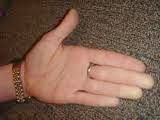Pallor is a pale color of the skin which can be caused by illness, emotional shock or stress, stimulant use, or anaemia, and is the result of a reduced amount of oxy hemoglobin in skin or mucous membrane.Pallor is more evident on the face ,palms,conjunctiva,tongue etc.. It can develop suddenly or gradually, depending on the cause. It is not usually clinically significant unless it is accompanied by a general pallor pale lips,tongue,palms,mouth etc.
Paleness, also known as pale complexion or pallor, is an unusual lightness of skin color when compared with your normal hue. Skin color is determined by several factors, such as the amount of blood flowing to the skin, skin thickness, and the amount of melanin in the skin. Paleness is caused by reduced blood flow or a decreased number of red blood cells. Paleness can be generalized (all over) or local.
Anemia, a condition in which the body doesn’t produce enough red blood cells, is one of the most common causes of paleness. Anaemia can be acute (sudden onset) or chronic (developing slowly).
Acute anemia is usually the result of rapid blood loss from trauma, surgery, bleeding stomach ulcers, or bleeding from the colon.Symptoms of acute onset anemia include:rapid heart rate, shortness of breath,high or low blood pressure,loss of consciousness,irregular or absent menstrual period (DUB) etc.
Chronic anemia is very common. It can be caused by not having enough iron, B12 or folate in your diet. There are also genetic causes of anemia such as sickle cell disease and thalassemia (a genetic disorder that destroys red blood cells). Anemia that develops more slowly can be caused by diseases such as chronic kidney failure or hypothyroidism (when the body does not produce enough thyroid hormone). Certain cancers that affect the bones or bone marrow can also cause anemia due to slow blood loss over a period of weeks to months.
Local paleness usually involves one limb. You should see your doctor if you have sudden onset of generalized paleness or paleness of a limb.Arterial blockage (poor or lack of blood circulation) can cause localized paleness, typically in arms or legs. The limb becomes painful and cold due to lack of circulation.Untreated arterial blockage of a limb can result in gangrene, which can result in the loss of a limb.
Paleness accompanied by signs of blood loss such as fainting, vomiting blood, bleeding from the rectum or abdominal pain is considered a medical emergency. Shortness of breath and sudden onset of paleness, pain and coldness of a limb are also serious symptoms that require immediate medical attention.Your doctor will also review your medical history and perform a physical examination to check your vital signs (heart rate and blood pressure). Pallor can often be diagnosed on sight, but can be hard to detect in people with dark complexions.
Investigations: CBC (complete blood count, evaluates if you have anemia),reticulocyte count (a blood test that shows if your bone marrow is replacing blood loss),stool test for the presence of blood,,thyroid function tests (low levels of thyroid hormone causes anemia),BUN and creatinine (kidney function tests),serum iron, B12, and folate levels (to see if nutritional deficiency is causing anemia)
Treatment
- Balanced diet, and iron (oral/parenteral), B12 or folate supplements,vitamin supplements
- Erythropoietin to stimulate RBC production
- Blood Transfusion may be necessary in some cases
- Anti-malarials,de-worming therapy,
- surgery is an option for certain causes of acute blood loss, such as trauma. Surgery may also be required for treatment of arterial blockage.
The long-term consequences for non-treatment of pallor depend upon the underlying cause. Untreated anemia due to blood loss can be fatal. Severe nutritional anemia can lead to other long-term health issues recurrent infections,cardiac failure,.
.
The development of pallor can be acute and associated with a life-threatening illness, or it can be chronic and subtle, occasionally first noted by someone who sees the child less often than the parents. The onset of pallor can provoke anxiety for parents who are familiar with the descriptions of the presentation of leukemia in childhood. In some instances, only reassurance may be needed, as in the case of a light complexioned or fair-skinned, non-anemic child.
Clinically, pallor caused by anemia usually can be appreciated when the hemoglobin concentration is below 8 to 9 g/d.The concentration of hemoglobin in the blood can be lowered by three basic mechanisms:
- Decreased erythrocyte production
- Increased erythrocyte destruction

 Performing surgery in such patients with restricted mobility and ventilatory difficulties is a challenging task.
Performing surgery in such patients with restricted mobility and ventilatory difficulties is a challenging task.































































